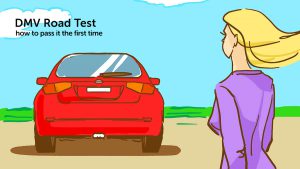Your progress:

Preparation Mistake #1:
Using Wrong Study Tools and Waiting Too Late
Your state’s official driving manual contains an enormous amount of information. However, these driving manuals are not usually written like textbooks organized into lesson units. The manuals are typically organized by topic. These topics include licensing regulations, driving rules such as how and when to yield the right-of-way, recommended best practices such as how to recover from a skid, and state-specific facts such as speed limits.
To prepare for your knowledge test, you need a study plan that makes the best use of your study time between now and the date of your test. Without such a study plan, you won’t study effectively. You may either procrastinate until the day before the test and then try desperately to cram for it, or you may waste too much time studying in ways that are ineffective.
Here is a sample four-week study plan.
Feel free to modify it according to how much time you have before your knowledge test and how much driving experience you already have.
Days 1 – 2: Research.
Visit your state DMV’s website and download the latest official DMV manual (if you haven’t already downloaded it from the Driving-Tests website). Also, access DMV webpages and download the DMV’s supplementary brochures and papers on such topics as drunk driving, insurance requirements, licensing requirements, your state’s Graduated Driver Licensing (GDL) program, and your state’s penalty points system if it has one. These materials may help update or clarify points in the manual that are obscure or out of date.
Days 3 – 5: Scan the manual.
Read through the whole manual and supplementary materials once. Note which topics, if any, the manual says definitely will (or will not) appear on the knowledge test.
Classify each section of the manual by the types of information it contains:
• Traffic control devices (e.g., signs, traffic signals, pavement markings)
• Driving rules that you must obey (“must” or “required”) (e.g., right-of-way rules)
• General good driving practices (“should”) (e.g., how to recover from a blowout or skid)
• State-specific, often numerical facts (“feet,” “miles”) (e.g., how close you may legally park to a fire hydrant in your state)
Days 6 – 10: Study the manual and supplementary materials.
To help you remember the information, each type of information listed above should be studied appropriately:
• Traffic control devices: Flashcards
• Driving rules that you must obey: Mental visualization; careful observation as a passenger or pedestrian; sketches of maps or intersections; Google Maps Street View images of roads and intersections from the driver’s point of view
• General good driving practices: Mental visualization; careful observation as a passenger or pedestrian; advice and anecdotes from more experienced drivers (because good driving practices are rarely state-specific)
• State-specific, often numerical facts: Rote memorization; flashcards
Days 11 – 16: Take practice tests.
Note which questions you missed and identify topics you need to study more.
Days 17 – 20: Study topics whose questions you missed.
Retake practice tests until your test scores are as high as you can get them.
Day 21: Gather items you’ll need to take to the DMV with you for the knowledge test and (if you pass) your new instruction (learner’s) permit or driver’s license.
Day 27: Prepare your mind and your body for the knowledge test.
Try to reduce your overall stress level. Get plenty of sleep.
Day 28: Start your day off right with a protein-packed breakfast and some light exercise.
Review your training materials one last time, too. Good luck on your knowledge test!



